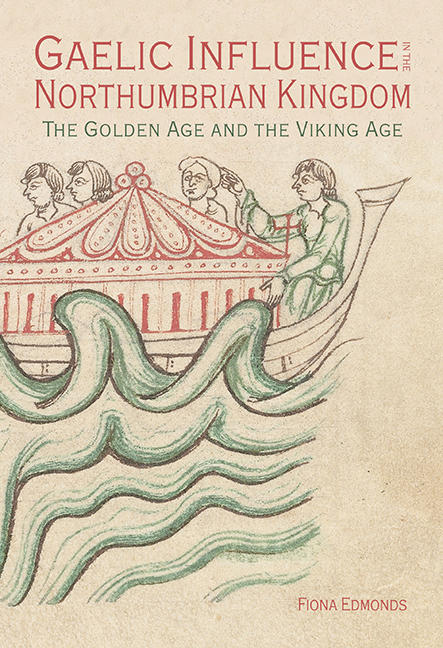Book contents
- Frontmatter
- Contents
- List of Illustrations
- Acknowledgements
- List of Abbreviations
- Preface: An Eventful Voyage
- 1 Concepts and Historiography of the Northumbrian and Gaelic Worlds: Medieval to Modern
- 2 Exiles and Emperors: Gaelic-Northumbrian Political Relations in the Golden Age
- 3 Fragmentation and Opportunity: From the Eighth Century to the Viking Age
- 4 Pathways through the Past: Routes between the Gaelic World and the Northumbrian Kingdom
- 5 A Golden Age of Ecclesiastical Contacts
- 6 Saints and Seaways in the Viking Age
- 7 Medieval Multilingualism: Gaelic Linguistic Influence in the Northumbrian Kingdom
- 8 Movement and Material Culture in the Northumbrian and Gaelic Worlds
- Conclusion: Individuals and Influences
- Bibliography
- Index
- STUDIES IN CELTIC HISTORY
5 - A Golden Age of Ecclesiastical Contacts
Published online by Cambridge University Press: 28 February 2020
- Frontmatter
- Contents
- List of Illustrations
- Acknowledgements
- List of Abbreviations
- Preface: An Eventful Voyage
- 1 Concepts and Historiography of the Northumbrian and Gaelic Worlds: Medieval to Modern
- 2 Exiles and Emperors: Gaelic-Northumbrian Political Relations in the Golden Age
- 3 Fragmentation and Opportunity: From the Eighth Century to the Viking Age
- 4 Pathways through the Past: Routes between the Gaelic World and the Northumbrian Kingdom
- 5 A Golden Age of Ecclesiastical Contacts
- 6 Saints and Seaways in the Viking Age
- 7 Medieval Multilingualism: Gaelic Linguistic Influence in the Northumbrian Kingdom
- 8 Movement and Material Culture in the Northumbrian and Gaelic Worlds
- Conclusion: Individuals and Influences
- Bibliography
- Index
- STUDIES IN CELTIC HISTORY
Summary
In the popular imagination, Northumbrian–Gaelic interaction is often associated with the atmospheric site of Lindisfarne. The tidal island, at once remote from the mainland and yet visible from Bamburgh, seems to evoke the spirit of ‘Celtic Christianity’. Lindisfarne's community enjoyed theological, intellectual and artistic interchanges with their counterparts elsewhere in the Insular world and beyond. These cultural connections arose from the travels of churchmen, skilled craftspeople and manuscripts. In this chapter, I examine ecclesiastical links from the perspective of Church organisation, and I explore how the northern and western edges of the Northumbrian kingdom sustained ecclesiastical relations.
My geographical focus lends itself to a study of churches and their networks. No manuscripts have survived from the west and north of the kingdom, which rules out consideration of artistic and intellectual exchanges. Even so, it is worth reflecting on recent research into those topics in order to place my study in its broader cultural context. During the earliest phases of interaction, Irish churchmen helped to devise an alphabet for Old English, most likely to assist Anglo-Saxons who were studying in Ireland. The Northumbrian tradition of glossing manuscripts in the vernacular may owe something to this tutelage in Ireland, where the vernacular was written at an early stage. Budding Northumbrian scholars flocked to churches associated with the Romani, a group who had adopted the dating of Easter that was current in Rome. These churches were located in the south of Ireland, creating a strikingly different pattern of contact from the more northerly political links that I have explored. Northumbrian students resided at churches such as St Berrihert's Kyle, Toureen Peacaun (Co. Tipperary) and Tulach Léis na Saxan (Tullylease, Co. Cork), where the English name ‘Berechtuine’ appears on an intricately carved slab. Another important community was Ráith Máelsigi (identified with Clonmelsh in Leinster) from which the Northumbrian Willibrord launched a mission to Frisia. Texts passed from this part of Ireland to Northumbria; for example, Dáibhí Ó Cróinín has traced the movement of a computistical collection to Aldhelm in Wessex and thence to Bede. Aldhelm was a well-connected scholar who had been to Ireland and enjoyed a close friendship with the Northumbrian royal exile Aldfrith, a bond arguably forged on Iona. By the end of the seventh century the intellectual cultures of Ireland, Iona and several Anglo-Saxon kingdoms were closely interwoven.
- Type
- Chapter
- Information
- Gaelic Influence in the Northumbrian KingdomThe Golden Age and the Viking Age, pp. 99 - 126Publisher: Boydell & BrewerPrint publication year: 2020

